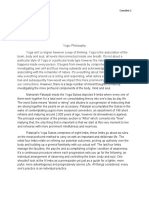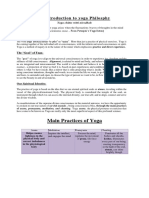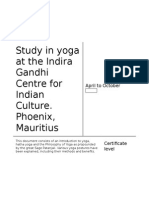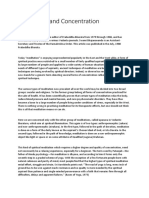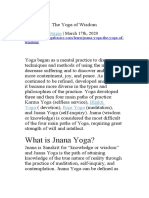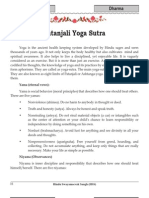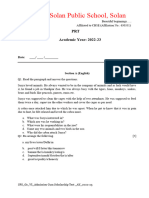YOGA24
YOGA24
Uploaded by
Sree Lakshmi TOriginal Description:
Original Title
Copyright
Available Formats
Share this document
Did you find this document useful?
Is this content inappropriate?
Report this DocumentCopyright:
Available Formats
YOGA24
YOGA24
Uploaded by
Sree Lakshmi TCopyright:
Available Formats
A Schedule Activity of Yoga 2023-24
INTRODUCTION
YOGA
Yoga is essentially a spiritual discipline based on an extremely subtle Science which
focuses on bringing harmony between mind and body. It is an art and science for healthy
living. The word "Yoga" is derived from the Sanskrit root yuj meaning "to join", "to yoke" or
"to unite". According to Yogic scriptures, the practice of Yoga leads to the union of
individual consciousness with universal consciousness. According to modern scientists,
everything in the universe is just a manifestation of the same quantum firmament. One who
experiences this oneness of existence is said to be "in Yoga" and is termed as a yogi who has
attained a state of freedom, referred to as Mukti, nirvāna, kaivalya or moksha.
"Yoga" also refers to an inner science comprising of a variety of methods through
which human beings can achieve union between the body and mind to attain self-realisation.
The aim of Yoga practice (sādhana) is to overcome all kinds of sufferings that lead to a sense
of freedom in every walk of life with holistic health, happiness and harmony.
Yoga works on the level of one's body, mind, emotion and energy. This has given rise to four
broad classifications of Yoga: Karma Yoga where we utilise the body; Jnāna Yoga where we
utilise the mind; Bhakti Yoga where we utilise the emotion and Kriya Yoga where we utilise
the energy. Each system of Yoga we practice falls within the gamut of one or more of these
categories. Two general theories exist on the origins of yoga. The linear model holds that
yoga originated in the Vedic period, as reflected in the Vedic textual corpus, and influenced
Buddhism; according to author Edward Fitzpatrick Crangle, this model is mainly supported
by Hindu scholars. According to the synthesis model, yoga is a synthesis of non-Vedic and
Vedic elements; this model is favoured in Western scholarship
Every individual is a unique combination of these four factors. Only a guru (teacher)
can advocate the appropriate combination of the four fundamental paths as is necessary for
each seeker. "All ancient commentaries on Yoga have stressed that it is essential to work
under the direction of a guru."
Department of CSE, CIT, Gubbi-572216. Page 1
A Schedule Activity of Yoga 2023-24
PATANJALI’S ASHTANGA YOGA:
The eight steps are the eight (Asht) angas (main limbs, or parts) in which the entire
Ashtanga yoga is divided. Each step builds up on its predecessor and is meant to purify a
certain area of one’s physical, mental existence in order to finally make the individual
eligible for knowing the ultimate truth.
The first five steps are collectively known as bahiranga, or the external means to know the
self and the last three are known as antaranga as the internal means to realize the self or reach
the state of Moksha, the final liberation of the soul.
1. Yamas or Restraining the Impurities
The first limb of ashtanga yoga is Yoga or restraint. As per Patanjali, their are
five restraints: Ahimsa ( non violence), Satya ( truthfulness), Non-stealing
( asteya), Discipline in sex ( brahmacharya), and Non-covetousness ( aparigraha).
These five virtues are essential to purifying the mind, only a pure mind can
remain steady and arrested.
The five yamas are the social virtues which require self-control, possession of
which is imperative upon stopping the mind, mental faculties, from remaining
entangled, lost in these outgoing tendencies, or the modifications of the mind.
Yamas are the first step of Ashtanga yoga because one must begin with what
should be kept away or what should not be indulged in in order to maintain the
cleanliness of the mind
2. Niyamas – Observances, Habits for Purifying
While yamas are something one must stay away from and are more concerned
about one’s interaction with the society, Niyamas, or observances are to be
adhered to and are more concerned about one’s own self.
Patanjali, through this niyama in his Ashtanga yoga stresses upon maintaining the
cleanliness of the mind as well as of the body. One must regularly keep the
physical body clear off any physical impurities like dust, grime or any other dirt
which can adhere to the body.
This is basically achieved by bathing the body every day with water, earth and
any other disinfectants. One must strive to keep the mind free of mental
Department of CSE, CIT, Gubbi-572216. Page 2
A Schedule Activity of Yoga 2023-24
impurities by ridding the mind of negative emotions like anger, jealousy, vanity,
and pride.
3. Yoga Asana – The Physical Posture
Asanas, the most popular step of the of the Ashtanga yoga is sequenced as the third
step in the yoga sutras of Patanjali.
Asana practice is more popular as the physical training system known as Hatha
yoga along with the benefits it offers. On the contrary Ashtanga yoga advocates the
practice of yoga asanas to calm down the involuntary bodily movements, agitations
due to impurities present in the nerve channels, as they can be a serious deterrent to
the efforts for steadying the physical body while one attempts to concentrate for
meditation as its highest goal.
Asana is any posture of the body wherein the body can remain steady for longer so
that the mind can remain concentrated undisturbed, from the occasional tremors
due to the impurities present in the physical body, for longer and deeper
contemplation on the self. Patanjali has defined asana as any posture which is
comfortable and steady.
4. Pranayama – Purifying the psychic channels
Respiratory movements can be another source of distraction for a mind that is
attempting to calm down. Moreover the respiratory movements and the mind are
directly related to each other; the slower, subtler the respiration the calmer is the
mind. Thus after the aspirant has achieved physical steadiness by practicing asana
he must practice pranayama for taming down the respiratory movements.
5. Pratyahara – control of the senses – Ashtanga Yoga
Pratyahara , means drawing the senses away from their objects. The senses are the
windows to the external world, all the senses keep feeding the mind with the
sensations they receive from their objects.
More the sensory impulses received by the mind more it will remain engrossed,
puzzled in interpreting and responding to them. Pratyahara, the fifth step of
Ashtanga yoga is about subjugating the sense organs to the will of the mind. The
mind gets to command over the senses and not otherwise which is a crucial
prerequisite to a successful meditation.
Department of CSE, CIT, Gubbi-572216. Page 3
A Schedule Activity of Yoga 2023-24
6. Dharana – Concentration
Dharana as the sixth step of ashtanga yoga is taking the mind after it was
withdrawn from the senses in the previous step, pratyahara, and tying it down to a
single object. Mind is like a drunk monkey, tie it to a place and within no time it
will be gone free again jumping from object to object.
The senses are the transporting agents of the mind which constantly keep it in
motion, or agitation. Thus the mind after being freed from the grip of the senses
needs to be fixed on one specific object where on it can stay for some time.
Fixing of the mind on one object is known as dharana or concentration. In case
this fixing of the mind is not done immediately after it is withdrawn from the
senses, pratyahara, there is a possibility of it again wandering aimlessly like
before or it will become passive. With concentration the power of the mind is
multiplied, a concentrated mind can achieve anything or everything.
7. Dhyana – Meditation, concentration on related thoughts
After the mind has been adequately trained to stay concentrated on an object the
stage of dhyana or meditation flows in on its own. Meditation is the unbroken
flow of the thoughts, realization of a single object, meditation has its many
advantages.
Thus concentration is about the mind selecting a single object out of the many,
and dhyana is staying on that for a considerable duration of time. The individual
consciousness becomes powerful in dhyana and the object appears more vivid
and detailed in its light. The mind can penetrate the object and know it
completely, and not just as it was appearing to the senses earlier.
8. Samadhi – object and the mind become one
Samadhi is the continuation of the state of concentration when the mind and the
object of concentration become one. The consciousness of the physical body
disappears and the mind becomes like the object. The object loses its form and
just appears like a bright light, the light of the object takes the possession of the
Department of CSE, CIT, Gubbi-572216. Page 4
A Schedule Activity of Yoga 2023-24
entire mind, the mind poses the consciousness of its own existence, then it is
called in a the state of samadhi
SURYA NAMASKARA:
Surya Namaskar is the Sanskrit name for a specific sequence of twelve yoga asana,
otherwise known as a Sun Salutation. It is one of the most widely known yoga practices,
incorporated into several different traditions such as Hatha, Vinyasa and Ashtanga. The term
is derived from two Sanskrit roots; surya, meaning "sun" and namaskar meaning "greetings"
or ‘salutations’".
Surya Namaskar is generally considered to be a morning practice, designed to harness
the prana shakti (life energy) which is most abundant at dawn. The sequence stimulates all
muscles, organs, systems and chakras in addition to cultivating concentration and stillness of
mind.
It provides a complete work-out for body, mind and spirit. It is an energizing and
efficient way to connect with inner strength and stability and is often used as a warm-up at
the start of a longer yoga practice.
The twelve asana which comprise Surya Namaskar are:
Pranamasana (Prayer Pose)
Urdhva Hastasana (Upward Salute)
Uttanasana (Standing Forward Fold)
Ashwa Sanchalanasana (Equestrian Pose or Low Lunge)
Chaturanga Dandasana (Plank Pose)
Ashtanga Namaskara (Eight Limbed Salute)
Bhujangasana (Cobra Pose)
Adho Mukha Svanasana (Downward-facing Dog Pose)
Ashwa Sanchalanasana (Equestrian Pose or Low Lunge)
Uttanasana (Standing Forward Fold)
Department of CSE, CIT, Gubbi-572216. Page 5
A Schedule Activity of Yoga 2023-24
Urdhva Hastasana (Upward Salute)
Pranamasana (Prayer Pose)
The transition from posture to posture is facilitated by either an inhalation or an
exhalation, allowing the practitioner to connect to their breath as a means of cultivating
concentration. The repetitive nature of Surya Namaskar fosters a meditative practice, in
which little thought needs to be given to the movement once it has been learned.
Additionally, Surya Namaskar provides many overall health benefits such as:
Maintaining cardiovascular health
Stimulating the nervous system
Improving strength and flexibility
Enhancing cognitive functions
Relieving stress and fatigue
Regulating hormones
The sequence should be practiced at least three times daily for maximum benefit.
Those who have issues with blood pressure or have had recent injuries or surgery should
check with a medical professional prior to practicing Surya Namaskar. Pregnant women may
need modifications for some of the postures and should consult an experienced prenatal
teacher before practicing.
Department of CSE, CIT, Gubbi-572216. Page 6
A Schedule Activity of Yoga 2023-24
ASANAS:
1. DANDASANA
Dandasana is Danda + Asana. Spine refers to Danda or stick, which remains
straight as staff and asana meaning pose. Dandasana interprets that position of the
body where our spine remains perpendicular to the flexed feet. Firm and flexed legs in
dandasana support the whole truck so it’s also called Base Pose. This asana demands
an erect posture with a right angle at the pelvis.
Dandasana is also known as a seated version of the Tadasana or Mountain
Pose. As Tadasana is a foundation of all the standing poses, in the same way,
Dandasana is base or foundation for seated or twisted asanas.
Benefits of Dandasana or staff pose:
The consistent practice of Dandasana develops awareness in the body.
The Staff Pose expands your upper body upwards and the lower body forward.
Practicing Dandasana gives you the feeling of grounding as your hips are flexed
well enough to keep the torso perpendicular to the floor.
As the principal focus in the Dandasana is to bring the torso perpendicular to the
floor, a lot of strength is needed at the hips to help support the back hence it
builds flexibility in the hip extensors and pelvic muscles.
This posture gives the basic strength to the core by just being seated in Staff Pose.
The abdominal area muscles can be worked at and strengthened. It strengthens all
the major core muscles. Psoas in the hips and upper leg, the erector spinae in the
lumbar back, and the transverse abdominus in the lower abdomen are all actively
engaged.
It strengthens the pelvic floor muscle and promotes the proper blood flow which
also improves the function of the sciatic nerve. By the consistent practice of
Dandasana, one can ease the pain of sciatica. Apart from this, it is also
therapeutic for asthma as it opens up a chest, which promotes the flow of oxygen.
Department of CSE, CIT, Gubbi-572216. Page 7
A Schedule Activity of Yoga 2023-24
As the spine is erect in this pose, the prana or subtle energy flow from the base of
the spine to the crown of the head through the chakras or energy centers.
Moreover, it channelizes the energy to the whole body and relaxes the brain,
nervous, and endocrine system. To experience the flow of prana, you need a
consistent practice of this pose and that for extended periods
2. URDHVA HASTASANA
Urdhva Hastasana is a standing pose that refreshes the entire body by boosting
energy levels. Whether you are a trained yogi, an aspirant, or even a novice, anyone
can perform this pose on a daily basis.
Every time you get up from long seated hours or wake up extending the arms
overhead and stretching the entire body from toes to fingertips. This subconscious
move re-energizes the body and forms Urdhva Hastasana.
Getting into the meaning, urdhva hastasana refers to “Raised Hands Pose”. It’s
also called Upward Salute Pose due to the Namaste gesture of hands. This gentle
stretch regenerates energetic spark and provides various therapeutic perks.
Urdhva Hastasana Benefits:
Improves posture
Stimulates the digestive system
Enhances pulmonary efficiency
Improves blood circulation
3. SARPASANA
Snake pose is an intermediate prone yoga pose. It is an advanced variation of
the Bhujangasana, which has almost similar benefits. This pose stretches the lungs,
shoulders, chest, and abdomen with increased influence on the thoracic region.
Sarpasana strengthens the spine and also helps in relieving stress.
Due to its dynamic approach, snake pose energizes the practitioner’s body and
for the same reason, it has been included in the flow yoga sequence. In classical Yoga,
Department of CSE, CIT, Gubbi-572216. Page 8
A Schedule Activity of Yoga 2023-24
Sarpasana is considered as the building block for the further advanced practice of
back bending Posture.
The Sarpasana is a Sanskrit term in which Sarpa means ‘Snake’ and ‘Asana’
means ‘Pose’. So, the practitioners practicing this pose resemble the snake where the
extended hands behind create a pull to lift the hood of the snake. Snakes are reptiles
that crawl and remain attached to the earth. This resembles the humble aspect of
practicing snake pose, which helps in keeping one’s ego in check.
Snake Pose Benefits:
The practice of snake pose has benefits concerning the respiratory, endocrinal,
reproductive, digestive, and spiritual.
Corrects the Round Shoulder
In young children, snake pose helps to strengthen core muscles as well as the
shoulders, back, and neck. It helps them differentiating between flexing and
arching their back
Develops Immunity and Resistance
Helpful in Diabetes
Activates Anahata Chakra
Overcomes Digestive Ailments
Strengthens Reproductive organs
4. APANASANA
Apanasana is a basic posture performed in the supine position. It is often
performed at the end of back stretching poses. However, it has lots of benefits
associated with it rather than just relaxing the body.
You just need to lie down on your back squeezing the knees up to the chest.
Wrap the arms around the shins and press the spine against the floor. It is as simple as
it seems.
Apanasana is composed of two Sanskrit terms, “apana” meaning “downward-
moving life force” and “asana” refers to “pose”. Apana is one of 5 Prana that signifies
the opposite of prana (upward flowing life force). “Prana” is described as a life-
Department of CSE, CIT, Gubbi-572216. Page 9
A Schedule Activity of Yoga 2023-24
giving force, however, “apana” is an “eliminating force”. Due to the eliminating
characteristics of this pose, it helps in removing toxins from the body, and hence the
name.
Apanasana Benefits:
Strengthens the back
Massages the abdominal organs
Improves blood circulation
Revitalizes the reproductive organs
5. KAPALBHATI
Our breath is one of the best remedies we have, to cope with anxiety or panic.
It is our breath that has amazing recuperative powers. The breath is intimately
connected with our mental and emotional state. Our breath influences our thoughts
and emotions and vice versa. The breath-emotion loop acts very quickly – just a few
minutes of deep breathing can calm your mind down.
By conscious breathing, we can activate our body’s innate response to relax.
By gradually regularizing our breath, we can help in decreasing the stress hormone,
and activating the lymphatic system which plays a critical role in our immune
function.
We also engage the parasympathetic nervous system which governs our
relaxation and regeneration response, making us more resilient to face challenges.
Benefits of Kapalbhati:
Increases the metabolic rate and aids in weight loss.
Enhances the capacity of the lungs and makes them stronger.
Clears the nadis (subtle energy channels).
Stimulates the abdominal organs and thus is extremely useful to those with
diabetes.
Improves blood circulation and adds radiance to the face.
Improves digestive tract functioning, absorption, and assimilation of nutrients.
Department of CSE, CIT, Gubbi-572216. Page 10
A Schedule Activity of Yoga 2023-24
Results in a taut and trimmed down belly.
Energizes the nervous system and rejuvenates brain cells.
Calms and uplifts the mind.
6. PRANAYAMA:
While we often simplify the term pranayama to mean “breathwork,” the yogic
meaning of pranayama is more nuanced.
In Sanskrit, “prana” means “life force,” and literally describes the energy that
is believed to sustain the life of the body. “Ayama” translates as “to extend, expand,
or draw out,” although some say that the word is actually dervied from “yama,”
meaning “control.”
Pranayama is a practice that involves the management or control of the breath.
As implied by the literal translation of the term, yogis believe that this practice not
only rejuvenates the body but actually extends life itself.
Pranayama consists of different breathwork techniques designed to gain
mastery over the respiratory process while recognizing the connection among breath,
mind, and emotions. Pranayama is an integral part of the yogic tradition, but not
always an easy one to grasp.
Benefits of Pranayama:
Reduces Stress and Anxiety
Improves Sleep
Lowers Blood Pressure
Improves Respiratory Function
Enhances Cognitive Function
Department of CSE, CIT, Gubbi-572216. Page 11
A Schedule Activity of Yoga 2023-24
PHOTOS:
Fig 10.1 Dandasana Fig 10.2 Apanasana
Fig 10.3 Urdhva hastasana
Department of CSE, CIT, Gubbi-572216. Page 12
A Schedule Activity of Yoga 2023-24
Department of CSE, CIT, Gubbi-572216. Page 13
You might also like
- 01 CN66531EN92GLA0 One NDS Components PDFDocument46 pages01 CN66531EN92GLA0 One NDS Components PDFPriya100% (1)
- PDF Zadie Smithx27s Fail Better Read Better - CompressDocument14 pagesPDF Zadie Smithx27s Fail Better Read Better - CompressLeila Mae SabasNo ratings yet
- Chapter 4-Functional Forms of Regression ModelDocument21 pagesChapter 4-Functional Forms of Regression ModelMuliana SamsiNo ratings yet
- Introduction To Yoga PhilosophyDocument33 pagesIntroduction To Yoga PhilosophyRahul Valiyakulangara100% (1)
- Yogic Philosophy EssayDocument6 pagesYogic Philosophy EssayCNo ratings yet
- Thelema 101 YogaDocument10 pagesThelema 101 YogaLuke.418No ratings yet
- 11 Physical Education - Yoga-NotesDocument11 pages11 Physical Education - Yoga-NotesAtu Kaushal100% (4)
- YogaDocument117 pagesYogauskeerthan6145No ratings yet
- Goal Card InstructionsDocument12 pagesGoal Card Instructionshportillo100% (2)
- Introduction To Yoga Philosphy PDFDocument13 pagesIntroduction To Yoga Philosphy PDFNishant DhimanNo ratings yet
- Introduction To Yoga Philosphy PDFDocument13 pagesIntroduction To Yoga Philosphy PDFNishant DhimanNo ratings yet
- The Eightfold Means of YogaDocument4 pagesThe Eightfold Means of YogaRaj MeenaNo ratings yet
- Yoga: Case StudiesDocument39 pagesYoga: Case StudiesRorro Saavedra100% (2)
- Philosophical Foundation of YogaDocument30 pagesPhilosophical Foundation of YogaAtu Kaushal100% (1)
- The Yoga SutrasDocument8 pagesThe Yoga SutrasSoham ShindeNo ratings yet
- YogaDocument34 pagesYogaManika RaiNo ratings yet
- YYoga and VE Materials 5UNITSDocument72 pagesYYoga and VE Materials 5UNITSGomathi RajendranNo ratings yet
- Patanjali Yoga Sutras or AphorismsDocument10 pagesPatanjali Yoga Sutras or AphorismsChandra BalaNo ratings yet
- Book Inside Pages Final Part 2Document77 pagesBook Inside Pages Final Part 2Rajiv Gulati100% (1)
- Ashtanga Yoga of PatanjaliDocument8 pagesAshtanga Yoga of PatanjaliAVINASH KEDIANo ratings yet
- Pysical Education Chapter - 3 YogaDocument7 pagesPysical Education Chapter - 3 Yogasiege gamerNo ratings yet
- Dharana, Ashtanga YogaDocument6 pagesDharana, Ashtanga YogaMahantheshaNo ratings yet
- Laya Yoga OBJECTTIVEDocument4 pagesLaya Yoga OBJECTTIVEMohan Kumar HNo ratings yet
- Assignment 7 For FDP On Yogadarshan Submitted by DR Devasia Muruppath Antony (Devasiamantony@hinducollege - Ac.in)Document2 pagesAssignment 7 For FDP On Yogadarshan Submitted by DR Devasia Muruppath Antony (Devasiamantony@hinducollege - Ac.in)Devasia M AntonyNo ratings yet
- Explain Ashtanga Yoga and Its Eight Limbs: 1. YamaDocument3 pagesExplain Ashtanga Yoga and Its Eight Limbs: 1. Yamars285225100% (1)
- Bodsphere's+eBook+ ++the+Eight+Limbs+of+Yoga+Document16 pagesBodsphere's+eBook+ ++the+Eight+Limbs+of+Yoga+Juliana LimaNo ratings yet
- Chapter 3 YogaDocument64 pagesChapter 3 Yogadevarshdoshi1305No ratings yet
- Concept of YogaDocument0 pagesConcept of YogaSaurabh ShankhdharNo ratings yet
- Yogi 2Document1 pageYogi 2RoushanNo ratings yet
- Indian Approaches To PersonalityDocument14 pagesIndian Approaches To PersonalityShanthala RaoNo ratings yet
- Integral YogaDocument5 pagesIntegral Yogaairan IshaNo ratings yet
- Yoga PhilosophyDocument28 pagesYoga PhilosophyNerissa Santos100% (1)
- Yoga and MeditationDocument9 pagesYoga and MeditationSahil AnsariNo ratings yet
- 8 Limbs Part 2Document5 pages8 Limbs Part 2Kevin LightNo ratings yet
- Ashtanga Yoga - Overview of Ashtanga Yoga StepsDocument4 pagesAshtanga Yoga - Overview of Ashtanga Yoga StepsJohnnyNo ratings yet
- Ashtanga Yoga - PatanjaliDocument2 pagesAshtanga Yoga - PatanjaliShruti KhanduriNo ratings yet
- Patanjali's Eightfold Path of YogaDocument4 pagesPatanjali's Eightfold Path of YogaRahul KhuranaNo ratings yet
- Relevance of Yoga in Modern TimesDocument59 pagesRelevance of Yoga in Modern TimesMallika P. Raman100% (3)
- Yoga Therapy For Holistic HealingDocument9 pagesYoga Therapy For Holistic Healingpresario223No ratings yet
- YOGADocument38 pagesYOGADhruv Damree100% (1)
- Meditation and Concentration Swami BhajananandaDocument37 pagesMeditation and Concentration Swami BhajananandaSudipta ShawNo ratings yet
- Antahkaran Panchkosh TrisharirDocument13 pagesAntahkaran Panchkosh TrisharirsurendermadaanNo ratings yet
- 11 Physical Education - Yoga-NotesDocument11 pages11 Physical Education - Yoga-NotesAbhinav Kumar50% (2)
- Importance of Yoga in Our LifeDocument23 pagesImportance of Yoga in Our Lifehukum sainiNo ratings yet
- Study Material YOGA B.Tech I SemesterDocument25 pagesStudy Material YOGA B.Tech I SemesterAditya SasaramNo ratings yet
- Steps in - Meditation PDFDocument3 pagesSteps in - Meditation PDFlovablesagiNo ratings yet
- The Koshas - 5 Layers of BeingDocument9 pagesThe Koshas - 5 Layers of Beinggeorgina_notNo ratings yet
- Yoga for Beginners: Ashtanga Yoga: With the Convenience of Doing Ashtanga Yoga at Home!!From EverandYoga for Beginners: Ashtanga Yoga: With the Convenience of Doing Ashtanga Yoga at Home!!No ratings yet
- YOGADocument38 pagesYOGARanaNo ratings yet
- YOga Schools by NileshDocument10 pagesYOga Schools by NileshNilesh TiwariNo ratings yet
- YogaDocument19 pagesYogaTaoshobuddha100% (1)
- Ashtanga YogaDocument18 pagesAshtanga Yogaadheena simonNo ratings yet
- Patanjali's Yoga Sutras: The Definitive Guide To Yogic WisdomDocument28 pagesPatanjali's Yoga Sutras: The Definitive Guide To Yogic WisdomLuana BlaNo ratings yet
- Basic Concept of Yoga Philosophyita-2Document6 pagesBasic Concept of Yoga Philosophyita-2Andrea BarraNo ratings yet
- What Is Jnana Yoga?: by - March 17th, 2020Document13 pagesWhat Is Jnana Yoga?: by - March 17th, 2020Rosalind AtkinsonNo ratings yet
- Psychology UGC NET - Emergence - 2Document5 pagesPsychology UGC NET - Emergence - 2mukeshpscprepsNo ratings yet
- Abhyasa Yoga The Yoga of Practice BR Achyutamrita ChaitanyaDocument4 pagesAbhyasa Yoga The Yoga of Practice BR Achyutamrita ChaitanyaRaghavNo ratings yet
- Patanjali Yoga Sutra: Dharma FebruaryDocument3 pagesPatanjali Yoga Sutra: Dharma FebruaryMohammad AbdoNo ratings yet
- 11th YogaDocument3 pages11th Yogatyagigame10No ratings yet
- Concentration and MeditationDocument54 pagesConcentration and MeditationKeyur PatelNo ratings yet
- Chapter 6Document16 pagesChapter 6Jeel ShahNo ratings yet
- Vibhuti PadaDocument50 pagesVibhuti PadaAnkit LatiyanNo ratings yet
- Competitive Dance Scoresheet: Competition Category Team Score CommentsDocument2 pagesCompetitive Dance Scoresheet: Competition Category Team Score CommentsArmel PerezNo ratings yet
- Derivation of Equations STR MTTFSDocument8 pagesDerivation of Equations STR MTTFSMarcus HartfelderNo ratings yet
- Varicose VeinsDocument52 pagesVaricose VeinsKelvin Maikana100% (1)
- Psychotherapy of Grief-2014-Erskine-279-90Document12 pagesPsychotherapy of Grief-2014-Erskine-279-90Alexandra ParvanNo ratings yet
- Drying of Solids (Sand)Document15 pagesDrying of Solids (Sand)Mahe Rukh75% (4)
- Masla e Falasteen Book ReviewDocument3 pagesMasla e Falasteen Book ReviewqazizaidkamalNo ratings yet
- Hydrogel Lab ReportDocument19 pagesHydrogel Lab ReportYasser Ashour0% (1)
- Where No Man Has Gone Before: A History of Apollo Lunar Exploration MissionsDocument562 pagesWhere No Man Has Gone Before: A History of Apollo Lunar Exploration MissionsPeter AylwardNo ratings yet
- Business Administration AssignmentDocument7 pagesBusiness Administration AssignmentMomina GondalNo ratings yet
- Lokendra 1Document7 pagesLokendra 1MahendraMeenaNo ratings yet
- T807Document4 pagesT807Pratik PrajapatiNo ratings yet
- Santamaria, M. A. "Critical Notes To The Orphic Poem of The Derveni Papyrus", ZPE 182, 55-76Document24 pagesSantamaria, M. A. "Critical Notes To The Orphic Poem of The Derveni Papyrus", ZPE 182, 55-76masanta11No ratings yet
- GrapevineDocument14 pagesGrapevineRohit ThakurNo ratings yet
- C++ SolutionDocument12 pagesC++ SolutionGobara DhanNo ratings yet
- MIS3300 Syllabus Su16Document9 pagesMIS3300 Syllabus Su16ongk0043No ratings yet
- UntitledDocument213 pagesUntitledNaynesh Patel100% (2)
- Jurnal Penting Mesenchymal Stem Cell 3Document19 pagesJurnal Penting Mesenchymal Stem Cell 3Adniana NareswariNo ratings yet
- 1690-Article Text-8561-1-10-20220914Document15 pages1690-Article Text-8561-1-10-20220914benyruhyatNo ratings yet
- Admission Test...... PRTDocument3 pagesAdmission Test...... PRTgaganNo ratings yet
- Jurnal Try Nur Hakim S - EngDocument19 pagesJurnal Try Nur Hakim S - EngTry NurhakimNo ratings yet
- Atypical Rolandic Epilepsy: Fifty Years of Landau-Kleffner SyndromeDocument4 pagesAtypical Rolandic Epilepsy: Fifty Years of Landau-Kleffner SyndromeilonaskorinNo ratings yet
- Most Used Words SubstitutionsDocument11 pagesMost Used Words Substitutionsanislinek15No ratings yet
- Property Law Examiner Report 2015 BDocument14 pagesProperty Law Examiner Report 2015 BEvelyn YingNo ratings yet
- Problem Set 1 AnswersDocument4 pagesProblem Set 1 AnswersSimon LeeNo ratings yet
- PorDocument12 pagesPorDenn Marc BeracisNo ratings yet
- Full Download PDF of (Original PDF) Mathematical Proofs: A Transition To Advanced Mathematics 4th Edition All ChapterDocument43 pagesFull Download PDF of (Original PDF) Mathematical Proofs: A Transition To Advanced Mathematics 4th Edition All Chapterhassadrugoo35100% (7)




